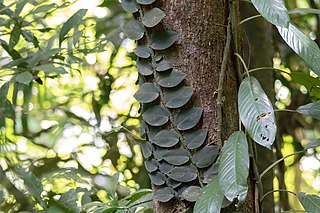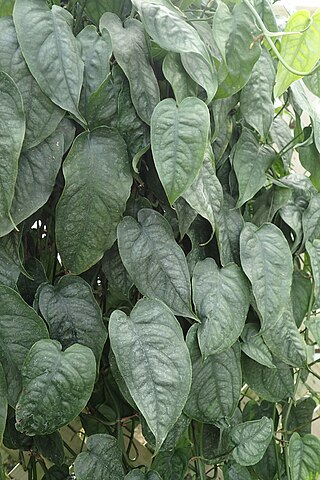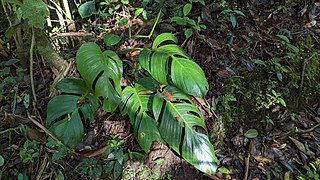
The Araceae are a family of monocotyledonous flowering plants in which flowers are borne on a type of inflorescence called a spadix. The spadix is usually accompanied by, and sometimes partially enclosed in, a spathe. Also known as the arum family, members are often colloquially known as aroids. This family of 140 genera and about 4,075 known species is most diverse in the New World tropics, although also distributed in the Old World tropics and northern temperate regions.

Variegation is the appearance of differently coloured zones in the leaves and sometimes the stems and fruit of plants. Species with variegated individuals are sometimes found in the understory of tropical rainforests, and this habitat is the source of a number of variegated houseplants. Variegation is caused by mutations that affect chlorophyll production or by viruses, such as mosaic viruses, which have been studied by scientists. The striking look of variegated plants is desired by many gardeners, and some have deliberately tried to induce it for aesthetic purposes. There are a number of gardening books about variegated plants, and some gardening societies specialize in them.

Monstera deliciosa, the Swiss cheese plant or split-leaf philodendron is a species of flowering plant native to tropical forests of southern Mexico, south to Panama. It has been introduced to many tropical areas, and has become a mildly invasive species in Hawaii, Seychelles, Ascension Island and the Society Islands. It is very widely grown in temperate zones as a houseplant.

Monstera is a genus of 59 species of flowering plants in the arum family, Araceae, native to tropical regions of the Americas.
Rhaphidophora pusilla is a species of plant in the family Araceae. It is found in Cameroon and Gabon. Its natural habitat is subtropical or tropical moist montane forests. It is threatened by habitat loss.

Epipremnum is a genus of flowering plants in the family Araceae, found in tropical forests from China, the Himalayas, and Southeast Asia to Australia the western Pacific. They are evergreen perennial vines climbing with the aid of aerial roots. They may be confused with other Monstereae such as Rhaphidophora, Scindapsus and Amydrium.

Monsteroideae is a subfamily of flowering plants in the family Araceae.

Thaumatophyllum bipinnatifidum is a plant in the genus Thaumatophyllum, in the family Araceae. Previously it was classified in the genus Philodendron within subgenus Meconostigma. The commonly used names Philodendron bipinnatifidum and Philodendron selloanum are synonyms. This plant is native to South America, namely to Brazil, Bolivia, Argentina, and Paraguay, but is also cultivated as a landscape plant in tropical, subtropical and warm temperate climates.

Rhaphidophora decursiva is a species of flowering plant in the family Araceae. It is native to China, the Indian Subcontinent, and Indochina.

Monstera epipremnoides is a species of flowering plant in the family Araceae, endemic to Costa Rica. A clone in cultivation was formerly thought to be of this species, but after comparison with wild populations of M. epipremnoides, the plant in cultivation has since been registered as a cultivar of the name Monstera 'Esqueleto'.

Rhaphidophora foraminifera is a species of flowering plant in the family Araceae. It is native to Borneo, Sumatra and Peninsular Malaysia.

Monstera adansonii, the Adanson's monstera, Swiss cheese plant, or five holes plant, is a species of flowering plant from family Araceae which is widespread across much of South America and Central America. Besides South American countries it can also be found in the West Indies on islands such as Antigua, Grenada, Saba, St. Kitts, Guadeloupe, Marie Galante, Dominica, Martinique, St. Lucia, St. Vincent, Tobago, and Trinidad. The species is quite common near river valleys at lower elevations.

Rhaphidophora hayi is a species of plant in the genus Rhaphidophora native to Queensland and New Guinea. It is an appressed or shingling semi-epiphytic vining plant that grows in wet tropical forests. 1016895-1
Monstera tacanaensis is a species of flowering plant in the genus Monstera of the arum family, Araceae.

Monstera siltepecana is a species of flowering plant in the genus Monstera native to the wet tropical biomes of southern Mexico and Central America. Like other Monstera species, it is a vining plant and as it matures, develops holes in its leaves. Especially in immature foliage, it has distinctive silver venation. The monstera siltepecana is a very fast growing plant along with the other arum family members.
Monstera guzmanjacobiae is a species of plant in the family Araceae from Mexico.
Monstera juliusii is a flowering plant in the arum family (Araceae). It is native to high-altitude cloud forests of Costa Rica at altitudes of 1,600 to 2,250 metres and occasionally confused with Monstera standleyana. However, M. standleyana has green petioles, few fenestrations and thin leaves, while M. juliusii is characterized by mottled white petioles, frequent fenestrations at maturity and thick, leathery leaves. Mature plants have pinnatilobed leaves as long as 60 cm and 30 cm wide, with circular fenestrations close to the margins, and oval fenestrations near the midrib. The species is named after Julius Johnson, son of the artists Rashid Johnson and Sheree Hovsepian.
Monstera minima is a species of flowering plant in the genus Monstera of the arum family, Araceae. Its binomial name minima refers to its tiny foliage, and it is indeed the smallest of the Monstera species when it comes to leaf size. It is most easily distinguished from other species in the genus due to the fact that its peduncles are much longer than its leaves.

Monstera monteverdensis is a species of flowering plant in the arum family, Araceae. Its adult form is characterized by pinnatifid margins with up to eight lobes per side, with occasional fenestrations away from the midrib. Leaves can grow as large as 60 cm long and 30 cm wide. It is named after the city of Monteverde, where the species is abundant.

Rhaphidophora pertusa is a climbing species of aroid plant within the genus Rhaphidophora of the Araceae family. The species—which, superficially, is quite similar to R. tetrasperma—is found on the Andaman-Nicobar Islands and the Maldives, as well as in Bangladesh, India, Myanmar, Thailand and Sri Lanka.















